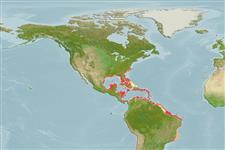Common names from other countries
Environment: milieu / climate zone / depth range / distribution range
Ecología
marino asociado a arrecife; rango de profundidad 0 - 30 m (Ref. 9626). Tropical; 45°N - 8°N, 99°W - 58°W (Ref. 55370)
Western Atlantic: Florida, USA to Brazil. Larvae are sometimes swept northward which accounts for the sighting of juvenile specimens as far north as Massachusetts, USA during summer months. One record (one specimen, 3 cm) from Musquodoboit Harbor, Nova Scotia, Canada.
Length at first maturity / Tamaño / Peso / Age
Maturity: Lm 13.9 range ? - ? cm
Max length : 20.0 cm TL macho / no sexado; (Ref. 7251)
Espinas dorsales (total): 12 - 14; Radios blandos dorsales (total): 18-21; Espinas anales 3; Radios blandos anales: 15 - 17. Body is white with a black bar running across the head through the eye. In juveniles, a second black bar runs from the base of the soft portion of the dorsal fin to the base of the anal fin. The dorsal, caudal and anal fins are either yellow or transparent (Ref. 4855). A narrow yellow bar from gill opening to pectoral base (Ref. 13442).
Inhabit shallow, coral reefs with clear water (Ref. 9626). Develop dusky bands at night. Generally common (Ref. 9710). Oviparous (Ref. 205). Form pairs during breeding (Ref. 205).
Life cycle and mating behavior
Madurez | Reproducción | Puesta | Huevos | Fecundidad | Larva
Form pairs during breeding (Ref. 205).
Randall, J.E., 1996. Caribbean reef fishes. Third Edition - revised and enlarged. T.F.H. Publications, Inc. Ltd., Hong Kong. 3nd ed. 368 p. (Ref. 13442)
IUCN Red List Status (Ref. 130435)
CITES (Ref. 128078)
Not Evaluated
Threat to humans
Harmless
Human uses
Acuario: Comercial
Herramientas
Special reports
Download XML
Fuentes de Internet
Estimates based on models
Preferred temperature (Ref.
115969): 23.9 - 28.2, mean 27.2 (based on 612 cells).
Phylogenetic diversity index (Ref.
82804): PD
50 = 0.5000 [Uniqueness, from 0.5 = low to 2.0 = high].
Bayesian length-weight: a=0.02570 (0.01537 - 0.04300), b=3.02 (2.88 - 3.16), in cm Total Length, based on LWR estimates for this species & Genus-body shape (Ref.
93245).
Nivel trófico (Ref.
69278): 3.7 ±0.2 se; based on diet studies.
Resiliencia (Ref.
120179): Alto, población duplicada en un tiempo mínimo inferior a 15 meses (Preliminary K or Fecundity.).
Fishing Vulnerability (Ref.
59153): Low vulnerability (10 of 100).
